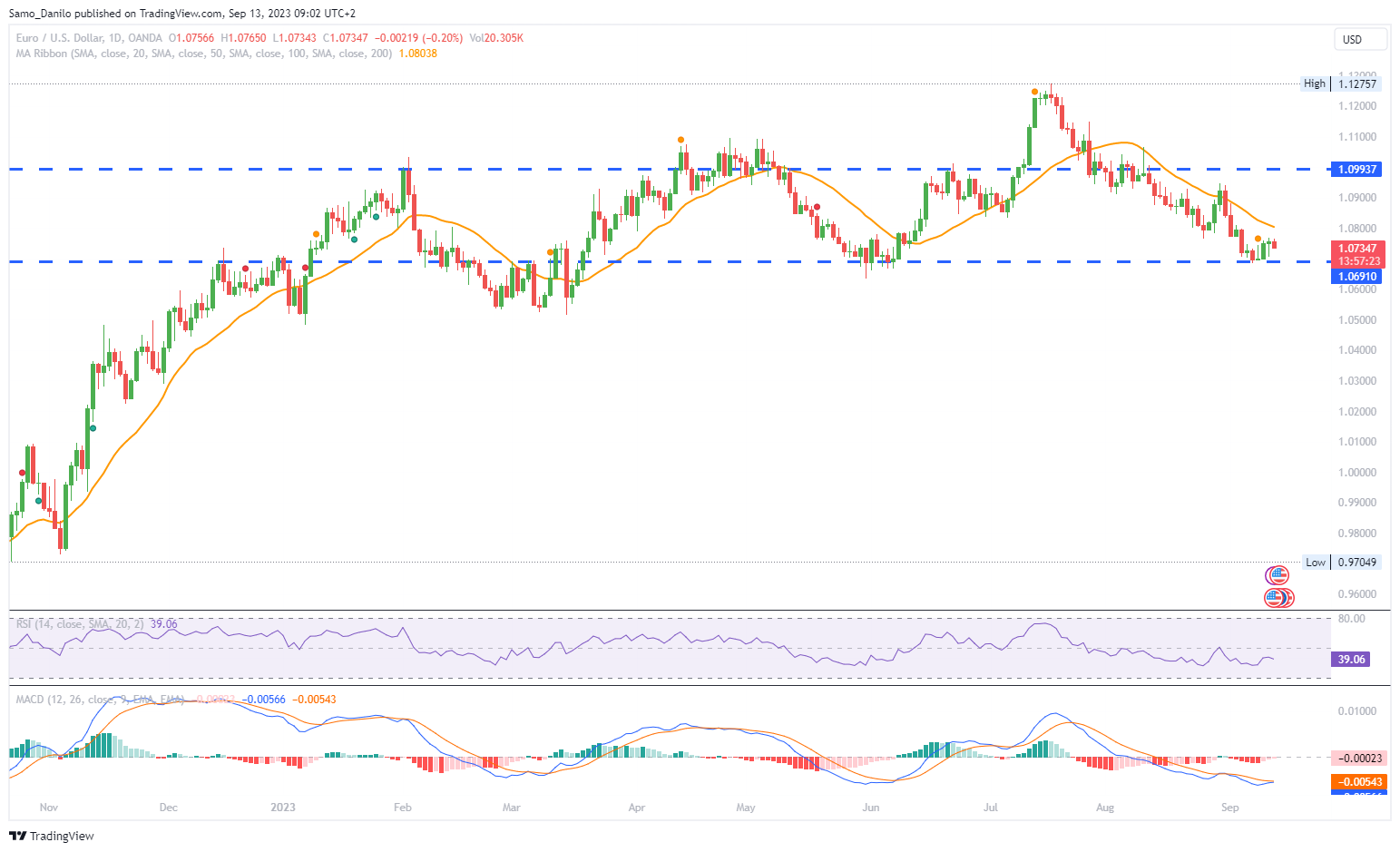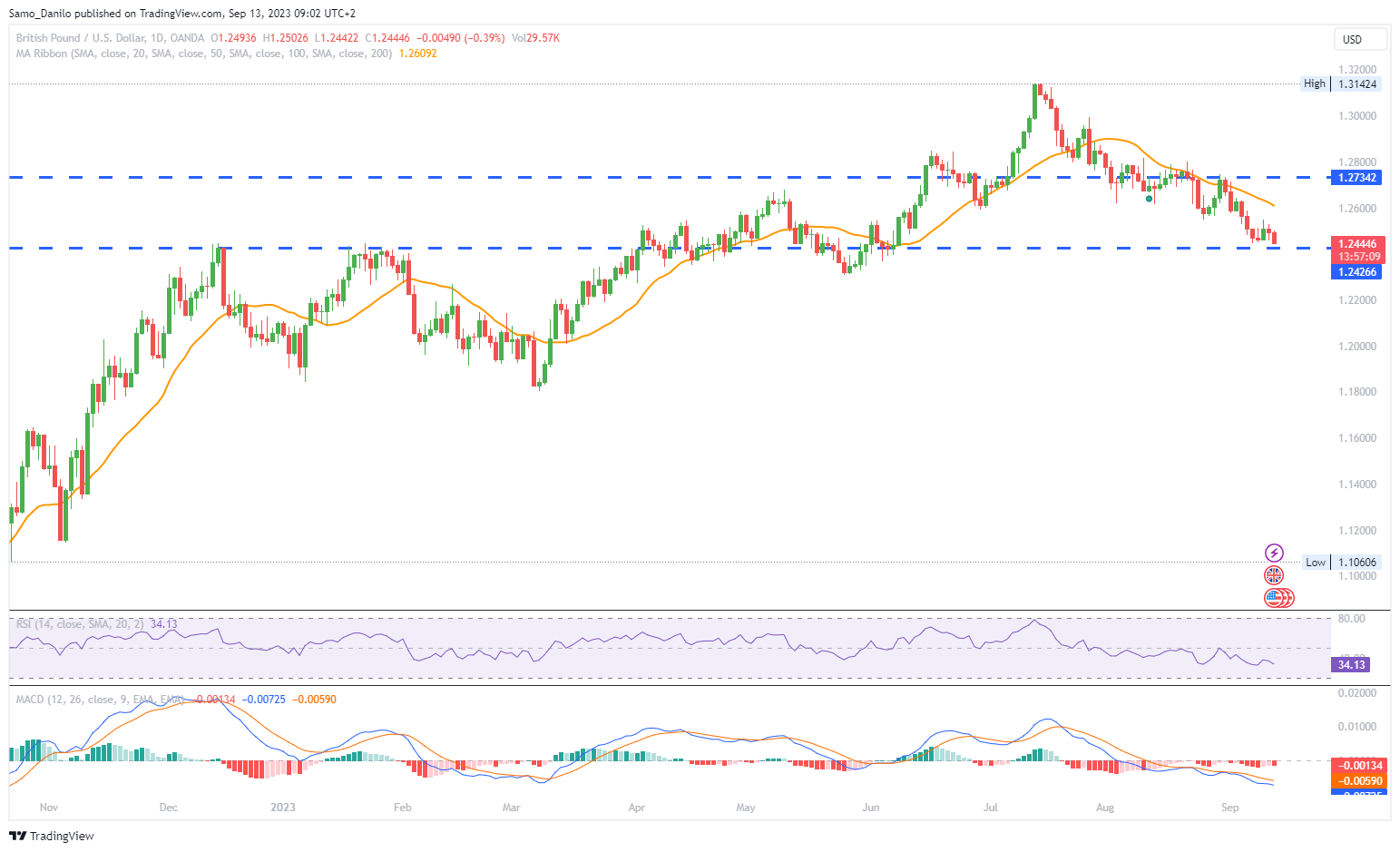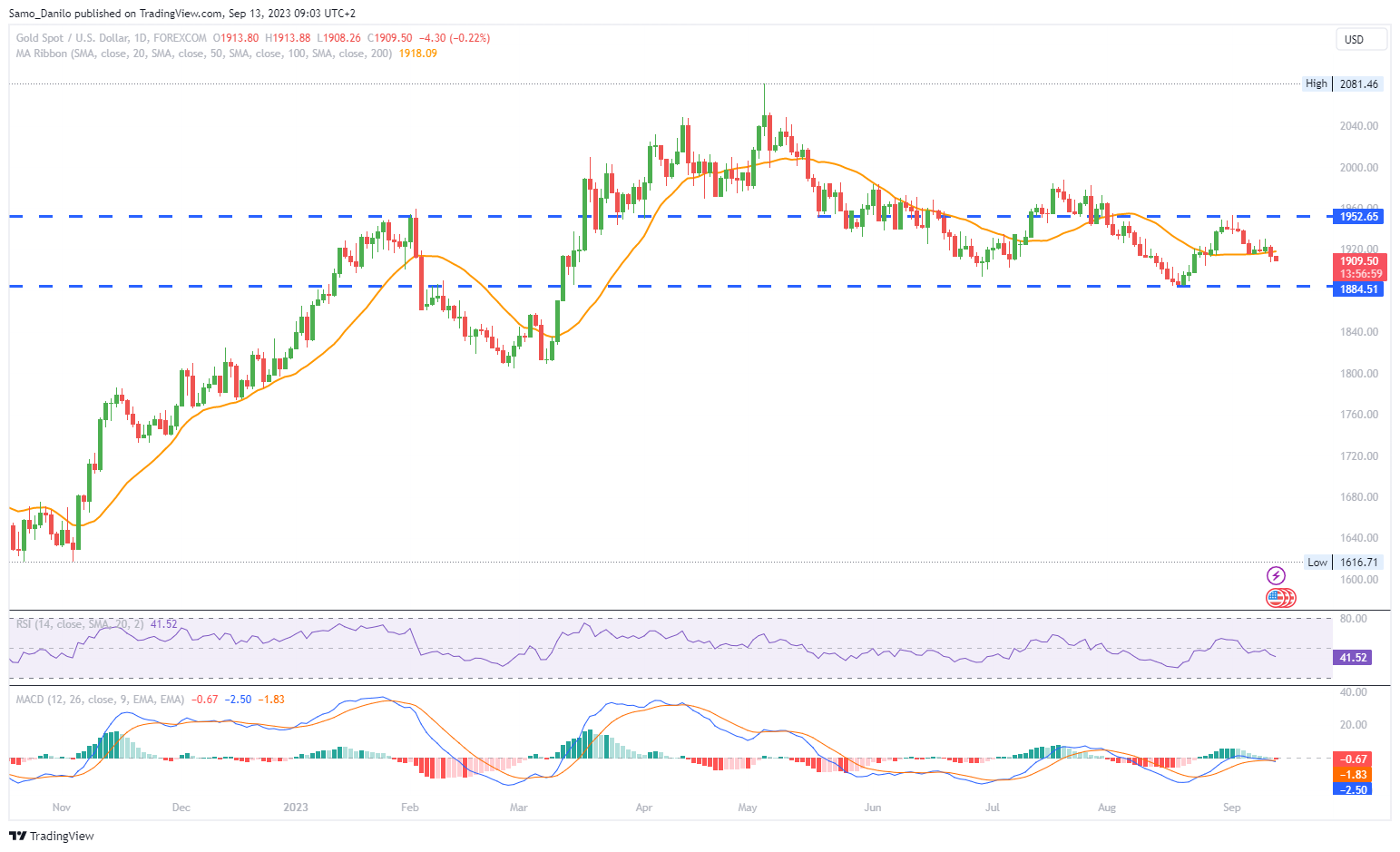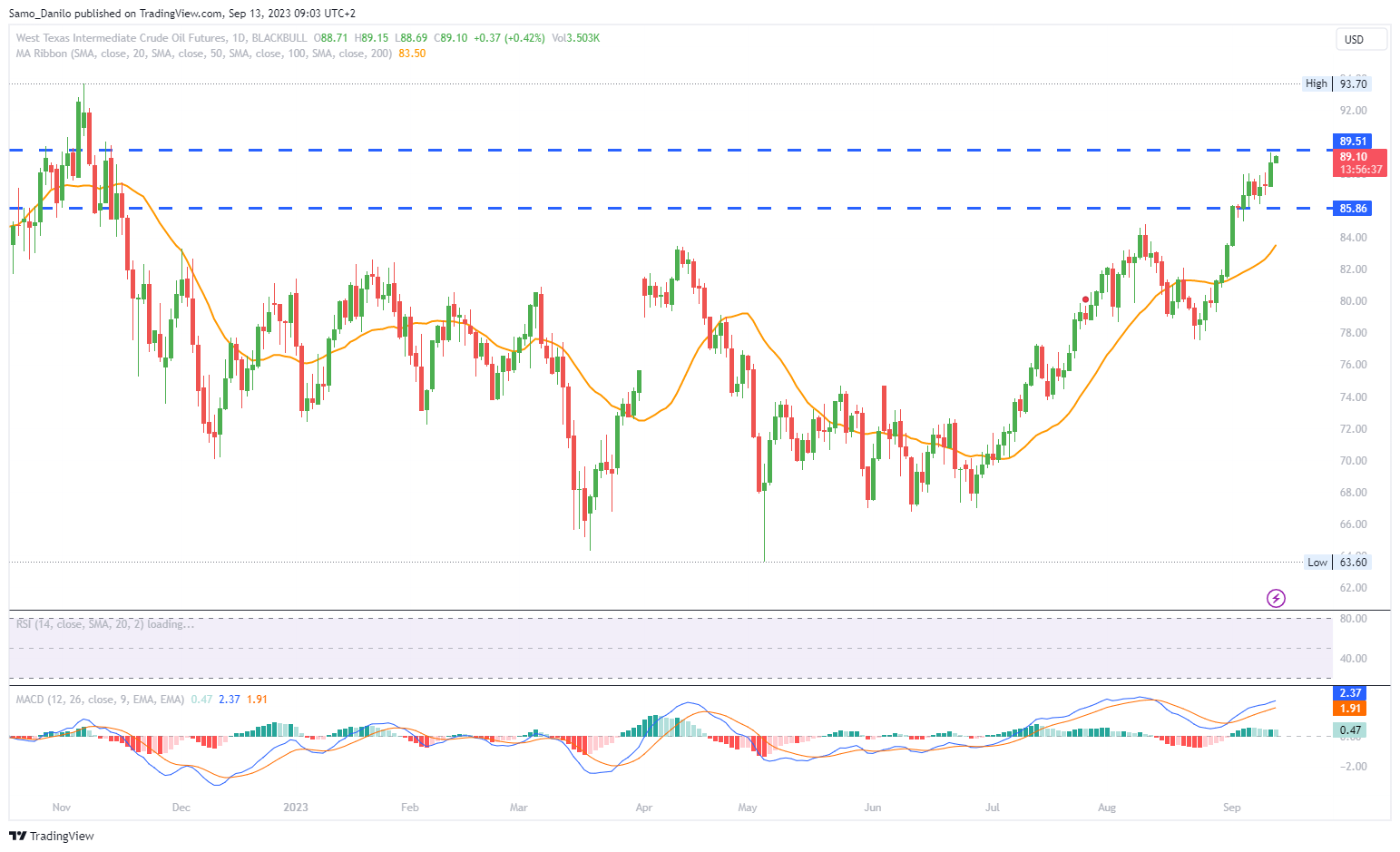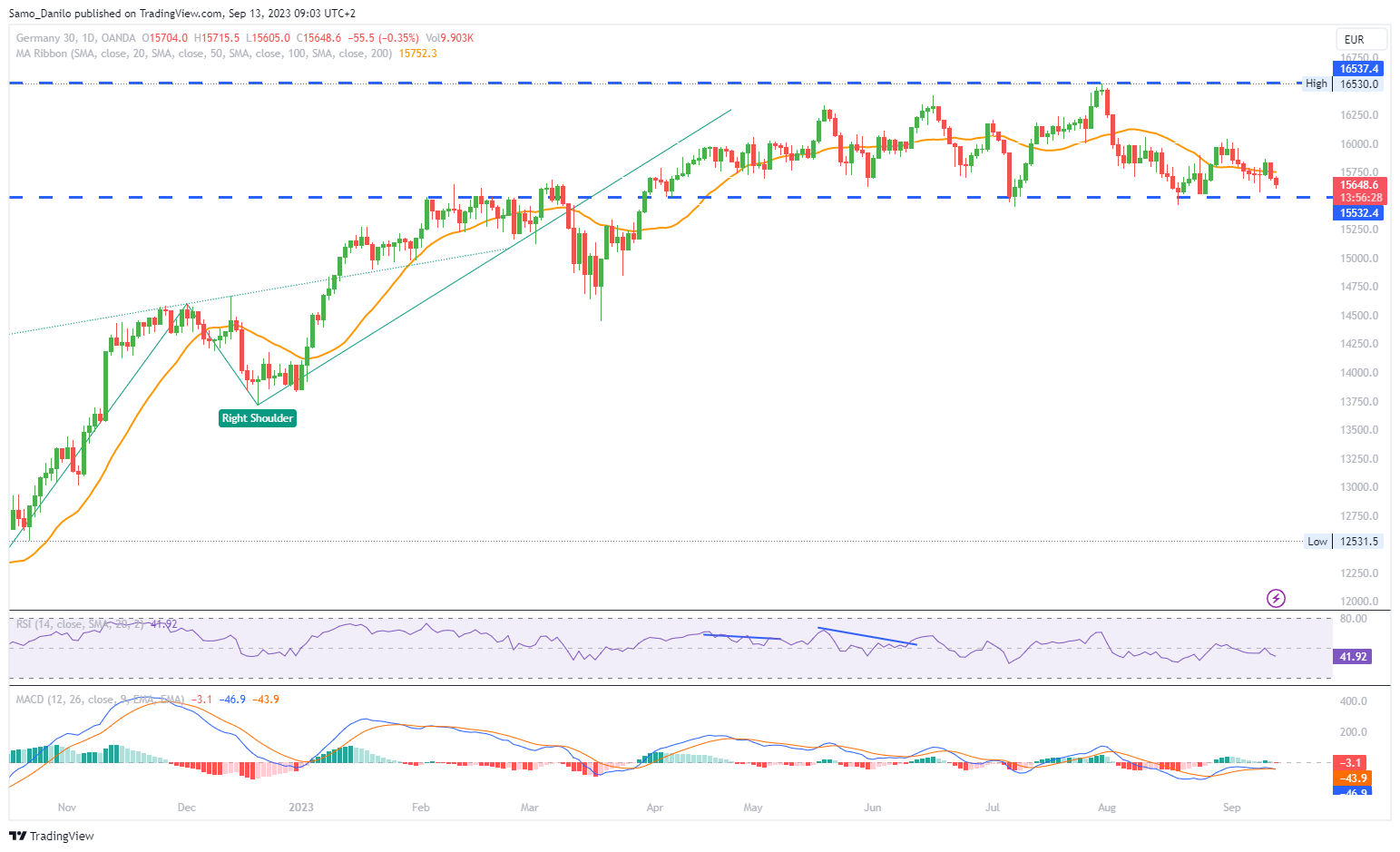EURUSD
- The EUR/USD pair is currently facing difficulties in gaining and holding ground above the mid-1.0700s during the early European session on Wednesday. This level is acting as a key support zone.
- On the daily chart, there is a significant bearish signal as the 20-day Simple Moving Average (SMA) has crossed below the 200-day SMA, which occurred around the 1.0830 level. This crossover confirms the overall downtrend in the EUR/USD pair.
- While the bearish trend is confirmed, the area around 1.0700 is still providing support. A break below this support level could signal the potential for further losses in the pair.
- Investors are closely awaiting the release of the US Consumer Price Index (CPI) data. This release is particularly important as it precedes the European Central Bank (ECB) interest rate decision. Market pricing currently suggests a nearly 50% chance of a rate hike by the ECB on Thursday, and many analysts anticipate at least one 25 basis points rate hike before the end of the year.
- The economic outlook of the Eurozone is a crucial factor that could limit any rebounds in the EUR/USD pair. Currently, the Eurozone's economic situation is not particularly promising, while the US economy appears to be more resilient despite its own challenges.
- Notably, no Federal Reserve officials are scheduled to speak this week due to the media blackout period ahead of the Federal Open Market Committee (FOMC) meeting, which is set to occur next week.
Closing statement: The EUR/USD pair is grappling with resistance around the mid-1.0700s while facing a confirmed downtrend signalled by the bearish moving average crossover. Upcoming events, such as the US CPI data and the ECB interest rate decision, are critical factors that can influence the direction of the pair. The economic outlook for both the Eurozone and the US plays a role in shaping market sentiment, with the US currently seen as having a more resilient economy.
GBPUSD
- The GBP/USD currency pair is currently experiencing renewed selling pressure and is testing the 1.2450 level. This decline follows mixed releases of UK GDP and Industrial Production data.
- The US Dollar Index (DXY), which measures the dollar's performance against a basket of six major currencies, has shown signs of stalling its retracement slide from a six-month peak reached last Friday. The dollar remains supported by expectations of further policy tightening by the Federal Reserve.
- The British Pound (GBP) could find some support from overnight hawkish remarks made by Bank of England (BoE) policymaker Catherine Mann, who stated that it was too soon to halt interest rate hikes.
- This follows BoE Governor Andrew Bailey's warning last week that borrowing costs might need to rise further due to persistently high inflation. These comments could contribute to limiting the downside for the GBP/USD pair.
- External BoE member Swati Dhingra also testified before the Treasury Select Committee, suggesting that interest rates are already sufficiently restrictive.
| SMA (20) | Falling |
|
|
| RSI (14) | Slightly Falling |
| |
| MACD (12, 26, 9) | Slightly Falling |
|
Closing statement: The GBP/USD pair is currently under selling pressure, with support for the US Dollar stemming from expectations of continued Federal Reserve policy tightening. However, hawkish comments from BoE policymakers, including Catherine Mann, and their concerns about persistent inflation, are factors that may limit the pair's downside. Swati Dhingra's testimony indicating that interest rates are already restrictive could provide some context for the BoE's approach to monetary policy.
GOLD
- The XAU/USD pair is currently trading around the $1,910 level and appears to be continuing its recent downtrend, which started from the $1,953 region, a one-month peak reached on September 1st.
- Gold prices are facing downward pressure due to fresh demand for the US Dollar as a safe-haven asset. This demand is driven by risk aversion in the markets, which often leads investors to seek the safety of the US Dollar during uncertain times.
- While the US central bank, the Federal Reserve, is widely expected to pause its rate-hiking cycle in September, the markets still retain the possibility of one more 25 basis point rate hike by the end of the year. This outlook is supported by recent upbeat US macroeconomic data, which suggests a resilient US economy.
- The fact that inflation is not cooling rapidly enough has given the Federal Reserve room to maintain higher interest rates for a longer duration. This hawkish stance on interest rates has contributed to elevated US Treasury bond yields.
- A cautious market sentiment, coupled with higher US Treasury bond yields and the hawkish outlook for interest rates, has revived demand for the safe-haven US Dollar, which in turn exerts downward pressure on gold prices.
| SMA (20) | Neutral | ||
| RSI (14) | Slightly Falling |
|
|
| MACD (12, 26, 9) | Neutral |
Closing statement: Gold prices are experiencing a decline, influenced by a stronger US Dollar driven by risk aversion and the Federal Reserve's hawkish outlook on interest rates. The expectation of one more rate hike by the end of the year, supported by resilient US economic data, has contributed to the current market dynamics.
CRUDE OIL
- Crude oil prices experienced an increase recently, maintaining their position near a 10-month high that was reached just a day before, as the market grapples with various supply and demand factors.
- The market is currently balancing concerns over oil supply, particularly related to Libya's output disruptions, and ongoing production cuts by the OPEC+ group of oil-producing nations. These cuts have contributed to the perception of tightening global oil supply.
- Both the OPEC and the U.S. Energy Information Administration (EIA) have presented a bullish outlook for oil demand. This positive demand forecast, coupled with the expectation of declining global oil inventories, has strengthened the belief in tightening oil supply in the future.
- It's noteworthy that the OPEC report revealed an increase in OPEC oil output for the month of August. This increase was attributed to higher production in Iran, despite ongoing U.S. sanctions against Tehran.
- Another factor supporting oil prices is the disruption of oil exports in Libya. The country closed four of its eastern oil export terminals due to severe weather conditions, which temporarily impacted its oil production and exports.
- The American Petroleum Institute (API) reported a build in U.S. crude oil inventories for the week ending September 8, with an increase of 1.174 million barrels. This contrasts with the previous week's decline of 5.521 million barrels.
| SMA (20) | Rising |
|
| |
| RSI (14) | Rising |
|
|
|
| MACD (12, 26, 9) | Rising |
|
|
Closing statement: Crude oil prices have been on the rise, supported by a mix of factors, including supply concerns related to Libya's output disruptions, ongoing OPEC+ production cuts, bullish demand outlooks from major organizations, and specific events such as Iran's increased production and the API's reported build in U.S. crude inventories. The market remains sensitive to both supply and demand dynamics, along with geopolitical developments.
DAX
- On Tuesday, the DAX experienced a decline of 0.54%, reversing the 0.39% gain observed on the previous trading day. The session concluded with the DAX index standing at 15,716 points.
- The economic indicators related to the Eurozone have been sending mixed signals, contributing to market uncertainty.
- A notable data release on Tuesday was the German ZEW survey, which provided mixed results. The index measuring the current economic conditions deteriorated further, reaching -79.4, marking its lowest level since August 2020, down from the previous -71.3. However, the Expected index exceeded expectations, coming in at -11.4 compared to a forecast of -15.0. These figures indicate ongoing challenges in the German and Eurozone economies, raising concerns about a potential recession. These factors are affecting expectations regarding the European Central Bank's stance on interest rates.
- The focus for today's trading will likely be on Eurozone industrial production data. Economists are anticipating a 0.7% decline in production for the month of July following a 0.5% increase in June. This data reflects the performance of the manufacturing sector and may influence market sentiment.
- It's important to note that both the European Central Bank (ECB) and the Federal Reserve have been closely monitoring inflation trends, and this remains a key factor influencing policy decisions. The ECB has been cautious about signaling interest rate hikes, even in the face of mixed economic data.
| SMA (20) | Neutral |
| RSI (14) | Neutral |
| MACD (12, 26, 9) | Neutral |
Closing statement: The DAX's performance has been influenced by mixed economic signals, including the recent German ZEW survey and the upcoming Eurozone industrial production data. These factors are intertwined with concerns about potential economic challenges and their implications for central bank policy, particularly regarding interest rates. As such, market participants are closely monitoring inflation trends and central bank statements for guidance.
